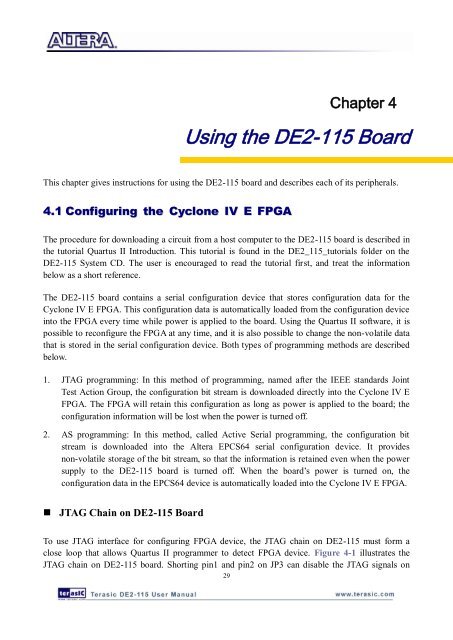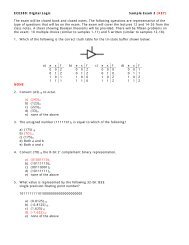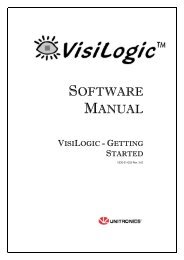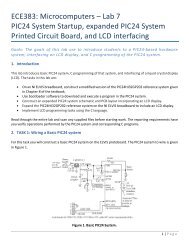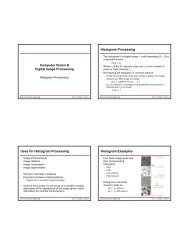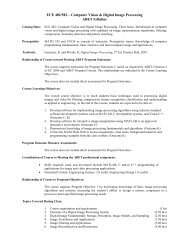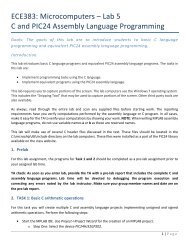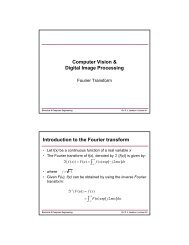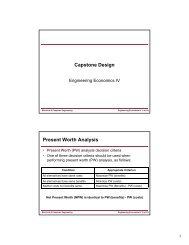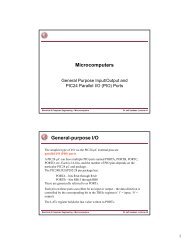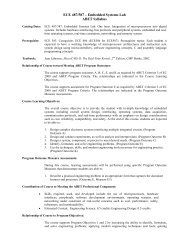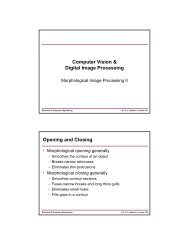DE2-115: User Manual
DE2-115: User Manual
DE2-115: User Manual
You also want an ePaper? Increase the reach of your titles
YUMPU automatically turns print PDFs into web optimized ePapers that Google loves.
Chapter 4<br />
Using the <strong>DE2</strong>-<strong>115</strong> Board<br />
This chapter gives instructions for using the <strong>DE2</strong>-<strong>115</strong> board and describes each of its peripherals.<br />
4.1 Configuring the Cyclone IV E FPGA<br />
The procedure for downloading a circuit from a host computer to the <strong>DE2</strong>-<strong>115</strong> board is described in<br />
the tutorial Quartus II Introduction. This tutorial is found in the <strong>DE2</strong>_<strong>115</strong>_tutorials folder on the<br />
<strong>DE2</strong>-<strong>115</strong> System CD. The user is encouraged to read the tutorial first, and treat the information<br />
below as a short reference.<br />
The <strong>DE2</strong>-<strong>115</strong> board contains a serial configuration device that stores configuration data for the<br />
Cyclone IV E FPGA. This configuration data is automatically loaded from the configuration device<br />
into the FPGA every time while power is applied to the board. Using the Quartus II software, it is<br />
possible to reconfigure the FPGA at any time, and it is also possible to change the non-volatile data<br />
that is stored in the serial configuration device. Both types of programming methods are described<br />
below.<br />
1. JTAG programming: In this method of programming, named after the IEEE standards Joint<br />
Test Action Group, the configuration bit stream is downloaded directly into the Cyclone IV E<br />
FPGA. The FPGA will retain this configuration as long as power is applied to the board; the<br />
configuration information will be lost when the power is turned off.<br />
2. AS programming: In this method, called Active Serial programming, the configuration bit<br />
stream is downloaded into the Altera EPCS64 serial configuration device. It provides<br />
non-volatile storage of the bit stream, so that the information is retained even when the power<br />
supply to the <strong>DE2</strong>-<strong>115</strong> board is turned off. When the board‟s power is turned on, the<br />
configuration data in the EPCS64 device is automatically loaded into the Cyclone IV E FPGA.<br />
• JTAG Chain on <strong>DE2</strong>-<strong>115</strong> Board<br />
To use JTAG interface for configuring FPGA device, the JTAG chain on <strong>DE2</strong>-<strong>115</strong> must form a<br />
close loop that allows Quartus II programmer to detect FPGA device. Figure 4-1 illustrates the<br />
JTAG chain on <strong>DE2</strong>-<strong>115</strong> board. Shorting pin1 and pin2 on JP3 can disable the JTAG signals on<br />
29


